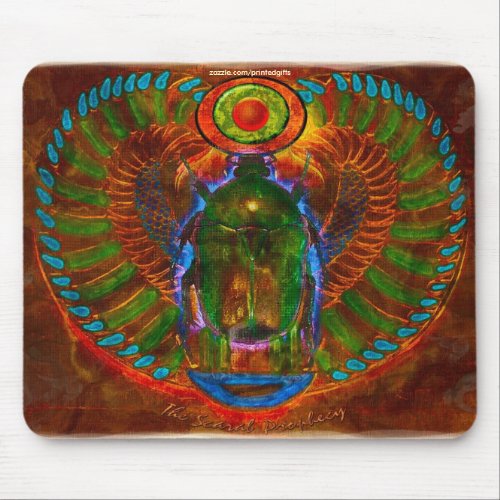Sacred Scarab Beetle Ancient Egyptian Art Mousepad



About "The Scarab Prophecy" ~ The Sacred Scarab Beetle is synonymous with ancient Egypt. This beautifully detailed artistic painting of the mystical Scarab was created by my artist friend Skye, from original designs in the Cairo museum collection in Egypt. "The Sacred Scarab in Egyptian Mythology According to their ancient texts, the Egyptians believed that the scarab beetle came into being spontaneously from balls of dung and they associated this with their religious ideology of self-creation and resurrection. Thus, the scarab beetle was worshipped under the name Khepri (meaning 'he who has come into being' or 'he who came forth from the earth'). As a self-created deity, Khepri became synonymous with the creator-god, Atum, of earlier times. Furthermore, in the same way that the scarab beetle pushed a ball of dung before it, the Egyptians imagined that Khepri rolled the sun (the solar 'ball') across the sky from east to west each day, and so they also regarded Khepri as a form of the sun-god, Ra (or Re). Hence, the scarab became an important symbol of creation, resurrection and everlasting life in the religious mythology of ancient Egypt. Small jars and coffins containing dried (mummified) scarabs were often placed in Egyptian tombs as part of their ancient funeral rites to ensure eternal resurrection (ref. 1). Large statues of scarab beetles were probably a common feature in ancient Egyptian temples - a colossal scarab statue is still preserved in situ beside the sacred lake in the temple of Amun at Karnak, and a similar colossal scarab carved in granite can be seen on display at the British Museum in London. The sacred 'sun' scarab, giving light and warmth, became a popular symbol in everyday life and small amulets (or seals) in the form of scarab beetles were produced in large quantities, either carved in stone or moulded in glass or faience (a ceramic material made from crushed quartz). The flat underside of such scarab amulets was often decorated with geometric patterns or hieroglyphic inscriptions (as shown in the picture below). Scarab amulets were sometimes set into elaborate pieces of jewelry, but more often they were pierced for threading on a simple cord necklace. There were also special unpierced funerial-type scarab amulets, like the so called 'heart scarab' shown below. These were placed with the mummified bodies of deceased people in their coffins and tombs as a symbol of resurrection and new life (ref. 2). 'Heart Scarab' amulet (left) carved in stone and unpierced - a funerial amulet usually placed on the chest of a mummified body under its swathing of bandages (circa 900 BC, 45 mm long). Scarab amulet (right) carved in stone and pierced longways for wearing on a necklace - the flat underside of this example is inscribed with three hieroglyphs depicting the dwarf-god, Bes, with tail and plumed head-dress - a protective deity to avert evil, especially during childbirth (circa 500 BC, 35 mm long). In Egyptian hieroglyphic text, the scarab symbol was used not only to represent the name of the creator-god, Khepri, as would be expected from the above mythology, but also to represent the word kheprer - meaning 'the flying beetle' or 'Sacred Scarab' itself - and the word kheper (or kheperu) - meaning 'become(s)' or 'manifestation(s) of...' (ref. 3). The scarab hierogyph often appears in the prenomen (one of the five titles and names) adopted by the Egyptian Pharaohs." Ref: http://www.kendalluk.com/scarab.htm


